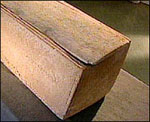 | | An empty ossuary, or limestone burial box for bones is seen with an inscription in Aramaic reading ' ``James, son of Joseph, brother of Jesus.'' |
An inscription on a burial artifact that was recently discovered in Israel appears to provide the oldest archaeological evidence of Jesus Christ, according to an expert who dates it to three decades after the rucifixion.
Writing in Biblical Archaeology Review, Andre Lemaire, a specialist in ancient inscriptions, says it is very probable the find is an authentic reference to Jesus of Nazareth. That Jesus existed is not doubted by scholars, but what the world knows about him comes almost entirely from the New Testament. No physical artifact from the first century related to Jesus has been discovered and verified. Lemaire believes that has changed, though questions remain, such as where the piece with the inscription has been for more than 19 centuries. The inscription, in the Aramaic language, appears on an empty ossuary, or limestone burial box for bones. It reads: "James, son of Joseph, brother of Jesus." Lemaire dates the object to 63 A.D. Lemaire says the writing style, and the fact that Jews practiced ossuary burials only between 20 B.C. and A.D. 70, puts the inscription squarely in the time of Jesus and James, who led the early church in Jerusalem. All three names were commonplace, but he estimates that only 20 Jameses in Jerusalem during that era would have had a father named Joseph and a brother named Jesus. Moreover, naming the brother as well as the father on an ossuary was "very unusual," Lemaire says. There's only one other known example in Aramaic. Thus, this particular Jesus must have had some unusual role or fame - and Jesus of Nazareth certainly qualified, Lemaire concludes. It's impossible, however, to prove absolutely that the Jesus named on the box was Jesus of Nazareth. (Agencies) | 近日,在以色列出土的一件陪葬品上的墓志铭有可能成为迄今年代最久远的能够证实耶酥基督存在的考古证据。专家鉴定,该陪葬品的年代应该是在耶酥殉难后的三十年。 对此,古代墓志铭专家安德烈·勒迈里在《圣经考古学评论》期刊中写道,这些墓志铭极有可能成为拿撒勒人耶稣存在的可信证据。 尽管对于学者来说,耶酥的存在从来就是不争的事实,但关于他的一切人们都只能从《新约》中获知。在这之前,从来没有发现任何从第一世纪留存下来的与耶酥存在有关的物品。勒迈里认为现在这一墓志铭的发现能够说明一些问题,尽管还有部分谜团未解。例如在过去的19个世纪中这份墓志铭究竟存在于何处等。  这份墓志铭写在一个空的存放尸骨的石灰石盒子上,上面用亚拉姆语写道:"詹姆士,约瑟夫之子,耶酥之兄。"勒迈里判断该墓志铭的年代为公元63年。 这份墓志铭写在一个空的存放尸骨的石灰石盒子上,上面用亚拉姆语写道:"詹姆士,约瑟夫之子,耶酥之兄。"勒迈里判断该墓志铭的年代为公元63年。
勒迈里说,公元前20年到公元70年之间,犹太人惯于用石灰石盒子盛放尸骨,而从该墓志铭的写作风格来判断,该墓志铭所指的就应该是当时在耶路撒冷领导早期教堂的耶酥和詹姆士兄弟。 尽管墓志铭中提到的三个名字在当时都很普遍,但勒迈里估计说当时的耶路撒冷最多只有20个詹姆士有叫约瑟夫的父亲和耶酥的兄弟。 而且,据勒迈里说,在墓志铭中同时提及兄弟和父亲的名字显得"很不寻常"。目前已知的在亚拉姆语中仅有一例。因此,勒迈里认为有理由相信这个"耶酥"一定有非同寻常的身份地位--而拿撒勒人耶稣就刚好具备这个条件。 尽管如此,科学家们仍然找不出任何足够充足的证据,来证明墓志铭中所说的"耶酥"就是拿撒勒人耶稣。 注:拿撒勒(Nazareth):西南亚巴勒斯坦地区北部古城 (中国日报网站译) |
